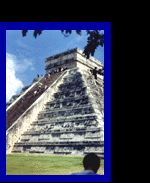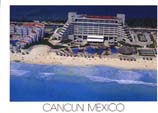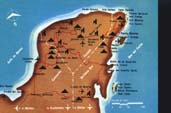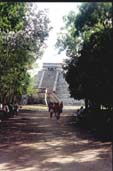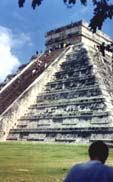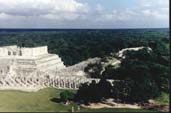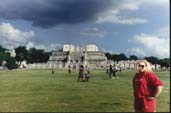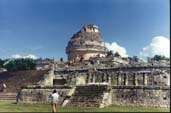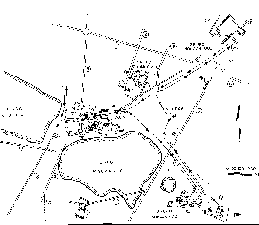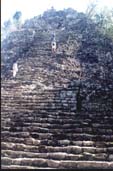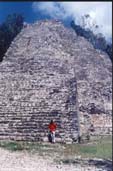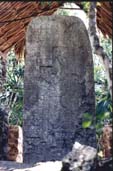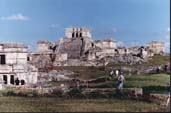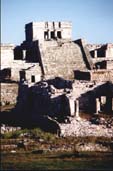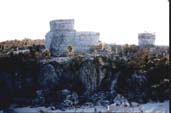| |
Yucatan 1995
We visited Cancun in1995 because we didn't get our act together
in time to go to Malaysia for the solar eclipse. As it turned out,
we had a terrific time visiting a bunch of Maya archaeological sites,
climbing over ruins and taking photos. Sally had a good time bargaining
for trinkets.
|
|
We stayed at the Royal Solaris Hotel
- an "all inclusive" with plenty of free beer - life
doesn't get much better than this. |
| Cancun is on the eastern coast of
the Yucatan penninsula, which means it gets hit hard by hurricanes
in the fall. |
|
Chichen-Itza
Chichen-Itza is probably one of the best known Maya cities in
the Yucatan, and probably the most visited. We took a tour bus from
Cancun to this site - a grueling 2 hour drive listenning to our
guide, a Maya-nationalist, who picked up the microphone as we departed
Cancun and didn't stop talking the entire trip.
|
|
Entry into Chichen-Itza is along
a beaten path through the jungle. The trees obscure the view
of the plaza effectively, so you don't see any of the structures
until you are almost there. Near the end of the path you round
a bend and have a stunning view of the Castillo - the largest
pyramid in the complex called "the Castle" by the
Spanish, but in actuality, it is the Temple of the Jaguar, built
on top of an older pyramid. |
|
The Temple of the Jaguar is really a temple within a temple.
The internal temple is accessible through a hidden stone staircase
that climbs inside, beneath the outer stairs you see here.
It was intended as an entrance for the priests, one at a time.
When we were there, there were dozens of people climbing up
and down the passage at the same time, making it hot, humid,
and claustrophobic. While we were able to climb it in 1995,
and see the famous blue jade jaguar inside, today (2002),
it is closed to the public.
|
|
|
|
At the top of the Temple of the Jaguar is
a building with four rooms - each with a doorway out to the
ledge around the top. Each doorway has wonderful carvings
around the edges, some with paint that is still visible. This
picture shows some of the carvings, and if you look closely
you can see some orange and blue paint.
|
|
Here is an ariel view of the Temple of the
Warrior, from the top of the Temple of the Jaguar. The views
are really terrific from the top, and we had lots of time
to appreciate them as we recovered from the arduous climb
up the 99 steps.
|
|
|
|
Behind me is the Temple of the Warrior.
It was roped off while we were there because of tourist-related
damage. On the top platorm is the sacraficial alter where the
Mayan priests would cut out the hearts of their victims - which
explains this building's popularity. |
| This is called El Caracol - meaning
The Snail, because of the spiral staircase inside. It may have
been a Mayan's observatory - notice the resemblence to Griffith
Park Observatory. |
|
Coba
After sitting through a tedious time-share sales presentation,
the best sales pitch the salesman gave us was to visit Coba, a largely
un-excavated Mayan city, probably the largest city the Mayans built.
|
|
Of course NOW (2002) there is a Club Med next door, but when
we were there we had to drive through the jungle for hours.
|
|
Coba is huge, but you'll see from the upcoming
pictures that it is almost completely covered with jungle.
Chichen-Itza is much smaller, but it is mostly cleared of
trees. It must have looked like Coba before it was excavated.
|
|
|
|
This is Nohoc-Mul, one of the taller
pyramids at Coba. Unlike Chichen-Itza, which has only one pyramic,
Coba has many tall pyramids, most of which look like humps of
greenery. Note the trees growing out of the sides and top. |
|
This view is from the top of one of the pyramids.
Note the pyramid (Nochoc-Mul) in the distance. It is only
identifiable as a pyramid because one side of it has been
excavated.
|
|
|
|
Here is Jim at the base of another
pyramid - just to give the building scale. The archaeologists
have cleared only one side of the pyramid. |
|
Coba is also known for its many Stelae - carved
stone pillars, usually depicting events in a specific king's
reign - the glory of battle, the conquering of enemies, marraige,
children, etc. They start carving when the owner is born,
and they keep adding to it during the owner's life as news-worthy
events occur
|
|
Tulum
Tulum is one of the two Maya cities surrounded by walls, and is
the only Maya city that overlooks the sea. It is one of the earlier
excavated sites, and is in terrific shape, having been completely
cleared and reconstructed. However, the buildings are roped off,
which means inquisitive visiters can't climb over the ruins.
|
|
This building is called "The Castle"
as well - I guess the Spanish weren't very imaginitive. If
you think this building looks familiar, you are correct -
Tulum is featured in most of the ads for Mexico.
|
|
Here's a closer view of the Castle, in the
late afternoon light.
|
|
|
|
Tulum is actually built overlooking the ocean.
This is a view of the backside of the Castle, with a bit of
the beach in the foreground.
|
Revised: June 9, 2002
Text Navigation
Home, Events,
Travel, Kids,
Cats, Links,
Contact, Site
Map
|

